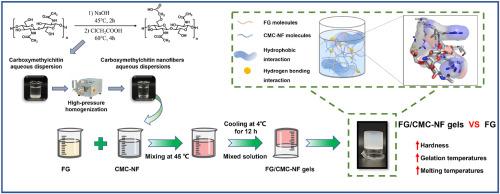Frabrication of carboxymethylchitin nanofibers and fish gelatin hybrid gels with robust gel performance
IF 11
1区 农林科学
Q1 CHEMISTRY, APPLIED
引用次数: 0
Abstract
Compared to animal gelatin, the application of fish gelatin (FG) in the food industry is limited due to its lower gel hardness, gelation temperature, and melting temperature. To address these issues, we developed hybrid gels using carboxymethyl chitin nanofibers (CMC-NFs) with FG to enhance its gel properties. The chitin was carboxymethylated by monochloroacetic acid, increasing the negative potential from −6 mV to −35 mV. This modified chitin was then defibrillated into CMC-NFs through high-pressure homogenization to improve its water dispersibility. The addition of 0.1% CMC-NFs significantly increased the hardness of FG gels from 533 g to 989 g, which was notably higher than the ∼600 g hardness of porcine gelatin. Additionally, the gelation and melting temperatures of FG reached 17 °C and 32 °C, respectively, which are very close to the 20 °C and 35 °C of porcine gelatin. Mechanistic studies revealed that FG and CMC-NFs (0.1%) molecules formed a synergistic gel network, facilitated by hydrogen bonding and hydrophobic interactions. This interaction significantly increased the α-helix content in the secondary structure of the FG protein from 15.26% to 21.18%, thereby enhancing the FG-dominated three-dimensional network structure with CMC-NF molecules. Increasing the concentration of CMC-NFs further elevated the gel's melting temperature while reducing its hardness due to phase separation. This study not only presents a viable method for enhancing the gelling properties of modified FG but also offers a feasible solution for expanding FG's applications in the food industry.

羧甲基几丁质纳米纤维和鱼明胶杂化凝胶的细化,具有稳定的凝胶性能
与动物明胶相比,鱼明胶(FG)的凝胶硬度、凝胶温度和熔化温度较低,因此在食品工业中的应用受到限制。为了解决这些问题,我们开发了羧甲基甲壳素纳米纤维(CMC-NFs)与鱼明胶的混合凝胶,以增强其凝胶特性。甲壳素被一氯乙酸羧甲基化,负电位从-6 mV升高到-35 mV。然后通过高压均质化将改性甲壳素脱纤为 CMC-NFs 以提高其水分散性。添加 0.1% 的 CMC-NFs 后,FG 凝胶的硬度从 533 克显著提高到 989 克,明显高于猪明胶的 600 克硬度。此外,FG 的凝胶化温度和熔化温度分别达到了 17 ℃ 和 32 ℃,与猪明胶的 20 ℃ 和 35 ℃ 非常接近。机理研究表明,FG 和 CMC-NFs (0.1%)分子通过氢键和疏水作用形成了协同凝胶网络。这种相互作用大大增加了 FG 蛋白二级结构中的α-螺旋含量,从 15.26% 增加到 21.18%,从而增强了 CMC-NF 分子以 FG 为主导的三维网络结构。增加 CMC-NF 的浓度可进一步提高凝胶的熔化温度,同时由于相分离而降低其硬度。这项研究不仅提出了提高改性 FG 胶凝性能的可行方法,还为扩大 FG 在食品工业中的应用提供了可行的解决方案。
本文章由计算机程序翻译,如有差异,请以英文原文为准。
求助全文
约1分钟内获得全文
求助全文
来源期刊

Food Hydrocolloids
工程技术-食品科技
CiteScore
19.90
自引率
14.00%
发文量
871
审稿时长
37 days
期刊介绍:
Food Hydrocolloids publishes original and innovative research focused on the characterization, functional properties, and applications of hydrocolloid materials used in food products. These hydrocolloids, defined as polysaccharides and proteins of commercial importance, are added to control aspects such as texture, stability, rheology, and sensory properties. The research's primary emphasis should be on the hydrocolloids themselves, with thorough descriptions of their source, nature, and physicochemical characteristics. Manuscripts are expected to clearly outline specific aims and objectives, include a fundamental discussion of research findings at the molecular level, and address the significance of the results. Studies on hydrocolloids in complex formulations should concentrate on their overall properties and mechanisms of action, while simple formulation development studies may not be considered for publication.
The main areas of interest are:
-Chemical and physicochemical characterisation
Thermal properties including glass transitions and conformational changes-
Rheological properties including viscosity, viscoelastic properties and gelation behaviour-
The influence on organoleptic properties-
Interfacial properties including stabilisation of dispersions, emulsions and foams-
Film forming properties with application to edible films and active packaging-
Encapsulation and controlled release of active compounds-
The influence on health including their role as dietary fibre-
Manipulation of hydrocolloid structure and functionality through chemical, biochemical and physical processes-
New hydrocolloids and hydrocolloid sources of commercial potential.
The Journal also publishes Review articles that provide an overview of the latest developments in topics of specific interest to researchers in this field of activity.
 求助内容:
求助内容: 应助结果提醒方式:
应助结果提醒方式:


